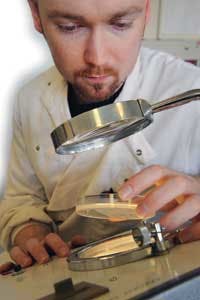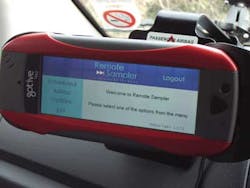By Colin Thurston and Gayle Gleichauf
Drinking water suppliers around the world face unique challenges: They must deliver the most essential ingredient for life on a grand scale, while also navigating complex issues surrounding public safety, regulations and aging infrastructure. In light of these challenges, how do water suppliers ensure that the millions of people around the globe who use public water receive a safe, reliable product? One common answer is comprehensive sampling and analysis of the water supply.
To comply with strict new standards, follow business best practices and, of course, keep customers safe and satisfied, water suppliers manage enormous testing programs, collecting and testing millions of water samples from myriad sources. Conducting and analyzing these tests is an immense undertaking, but laboratory information management systems (LIMS), which automate sample planning and laboratory processes and integrate analytical data from across the lab and outside, help modern labs keep pace.
Water Sampling Challenges
Over the last decade, the National Environmental Laboratory Accreditation Program (NELAP) and the EPA in the U.S., along with other regulatory bodies around the world, such as the European Commission and the Drinking Water Inspectorate in the UK, have instituted rigorous new standards for water testing. These regulations provide a set of protocols outlining what is acceptable within a multi-disciplinary water laboratory in accordance with internationally accepted standards.
Stringent requirements dictate new labor-intensive procedures to ensure compliance, such as sample tracking, chain of custody (COC), record keeping, demonstration of capability (DOC), document control, reagent and standard traceability, proof of training and reporting. And since water testing labs must work closely with municipalities, municipal utility districts, water control and improvement districts and federal and state regulatory authorities, the number of tests and the data they generate create a massive amount of information.
Water sampling includes tests for both process control and safety/regulatory compliance. Process control tests help streamline water treatment and increase throughput, whereas safety and regulatory compliance sampling ensures that the water supplier provides a consistently clean, appealing product that complies with government mandates.
Why a LIMS is Critical
LIMS are the key to addressing growing challenges with monitoring and compliance, and they have become more necessary and more prevalent in today's labs. Paper-based systems can no longer handle the volume of sample throughput, data management and reporting complexity in an effective manner. A LIMS schedules and holds sampling plans, which are then used to generate a collection run for each sampler. The collection run defines where samples must be taken, what sample bottles must be collected and what onsite tests must be performed. Samples are then analyzed in the laboratory, and water-quality data, as well as details of testing carried out in the field, are entered into the LIMS. This is important, as water companies must collect and analyze their water samples in a closely regulated environment, maintaining complete quality control records for submission to regulatory bodies or in case of audits.
An automated solution also provides water plant or utility managers with the data they need to make informed decisions that increase control and quickly resolve environmental issues and risks. A LIMS enables water companies to more easily comply with strict regulatory guidelines while simultaneously providing the flexibility necessary to cope with changing demands and practices as regulations and testing protocols change. A LIMS can even improve operational efficiency, as they provide laboratories with a centralized tool for comprehensive sample record keeping, management and reporting. By integrating the LIMS with laboratory instrumentation, online monitors and external sample collection, time-consuming manual processes and transcription errors can be eliminated.
While a LIMS can offer built-in functionality specifically designed for the water and environmental industry, it can also be configured to meet a company's evolving business model practices. With the right LIMS, a laboratory can be confident that the data system does not dictate how operations are run. Instead, its flexibility can allow the system to codify how a company wants to operate.
Case Study
Northern Ireland Water provides an example of a sophisticated water sampling program that takes full advantage of a LIMS. The government-owned company is the sole provider of water to Northern Ireland, serving 1.7 million people at 800,000 properties. Like U.S. water suppliers, the company must comply with strict regulations - in Northern Ireland Water's case, both EU and UK standards - which, in common with EPA regulations, are derived from the World Health Organization (WHO) Guidelines for Drinking Water Quality. These entail running more than 150,000 tests each year on samples collected from reservoirs, water treatment facilities and customers' homes.
To ensure that Northern Ireland Water continues to be a trusted and reliable public service provider, the agency transitioned from an in-house, customized LIMS to a Thermo Scientific SampleManager LIMS, a more robust and efficient solution purpose-built system for water testing laboratories and other process industries. The LIMS was employed for three main tasks: Receipt of samples for chain of custody from field procurement, sample login and storage at Northern Ireland Water laboratories and results and reporting to management and regulatory agencies.
Northern Ireland Water also took steps to automate the collection of field samples, integrating this program with the LIMS without making samplers' jobs any more difficult. New, ruggedized personal digital assistants (PDAs) made the field sampling process more efficient and improved the audit trail. The small, easy-to-use devices feature built-in GPS, GPRS, bar code readers, Wi-Fi and Bluetooth, all which provide more accurate data on sample location and identification. Remote sampler PDAs deliver sample information directly to the SampleManager LIMS, and the LIMS feeds collection and workflow data back to the PDAs so field personnel are continuously updated on priorities, sample collection locations and specific testing requirements.
The integration of a remote sampler field testing system with an enterprise-level LIMS has delivered essential transparency between data gathered in the field and management reporting generated by the LIMS. The automation of both the front-end sample collection and back-end reporting has eliminated manual transcription errors, and the quality of Northern Ireland Water samples and reporting has been significantly enhanced. The LIMS has also contributed to cost savings and reducing the water sample reception process by more than two hours per day.
Northern Ireland Water has also improved the integrity of samples and subsequent accuracy of data across two geographical areas. Enhanced field sampling allows the company to record precise locations for each sample - the GPS verifies customer tap sample locations by matching addresses against an on-board database. This portability also allows sampling staff to move around and exchange workloads to suit Northern Ireland Water's business needs: Samplers no longer require knowledge of local geography because the onboard GPS software gives them turn-by-turn directions to the sample point.
The results of this integrated program are impressive. In 2011/2012, the company delivered £12 million in operational cost efficiency savings after setting a goal of £10.4 million. Northern Ireland Water also improved wastewater compliance for the last six years in a row and won the Royal Society for the Prevention of Accidents Gold awards for health and safety in 2010 and 2011. Better still, last year less than one in 100 customers experienced an unplanned interruption lasing longer than six hours.
About the Authors: By Colin Thurston, Director of Product Strategy, Process Industries, Thermo Fisher Scientific and Gayle Gleichauf, Applications Lab Manager for Water Analysis Instruments, Thermo Fisher Scientific
WaterWorld Articles Archives






